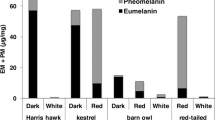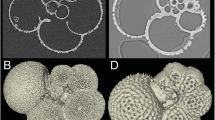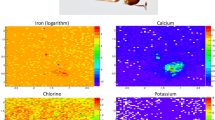Abstract
We have examined the anterior and middle hooks of many specimens of 3 species of acanthocephalans from Ukraine including (1) adults of Acanthocephalus ranae (Schrank, 1788) Lühe, 1911 from 4 species of frogs in 6 geographical locations, (2) adults of Southwellina hispida Van Cleave, (1925) Witenberg, 1932 from 3 species of birds in 2 geographical locations, and (3) adults and cystacanths of Sphaerirostris picae (Rudolphi, 1819) Golvan, 1956 from 1 species of birds, 1 species of lizards, and 1 species of mammals in 2 geographical locations, to analyze their Ca, S, and P spectra using Energy dispersive x_ray analysis (EDXA), and account for their intraspecific variabilities. Adults of each of A. ranae from frogs and adults of S. hispida from birds each showed comparable metal spectra irrespective of host species and geography, especially when metal weight percent figures are averaged. In S. picae, 5 adult specimens from birds had comparable spectra but the cystacanth from hedgehog, a mammal, had particularly dissimilar pattern with much lower levels of P and Ca. We have also studied the EDXA patterns in anterior, middle and posterior hooks of cystacanths, juveniles, and adults of Moniliformis kalahariensis Meyer, 1931 much lower levels of P and Ca. in South Africa, Botswana, and India collected from their invertebrate intermediate and vertebrate definitive hosts to examine the EDXA profiles. Our conclusions were comparable to those reached from the Ukrainian material with the additional emphasis on the importance of using the same developmental stage in comparing interspecific EDXA profiles. The importance of the stability of the levels of S in various developmental stages across the host species barrier is exemplified by its relationship to the genetically based protein synthesis, which gives credibility to the usage of EDXA for diagnostic purposes. Our findings show that EDXA is a useful tool to characterize the taxonomic identity of species of Acanthocephala providing that (1) a population of a number of individual specimens are analyzed and average weight percent figures of metals are used for comparisons, and (2) comparisons are made using specimens of the same developmental stage and from hosts of the same class of vertebrate. When these conditions are met, the metal spectra for each species will prove valid for diagnostic purposes.




Similar content being viewed by others
Data availability
All presented and related data are available by contacting the senior author.
References
Amin O. M., Ahmed, M., Chaudhary, A., Heckmann, R. A., & Singh, H. S. (2022a). The morphological and molecular description of Neoechinorhynchus (Neoechinorhynchus) poonchensis sp. n. from Schizothorax richardsonii (Gray) in Poonch, Jammu and Kashmir, India. Folia Parasitologica, 69, 1.
Amin, O. M., Chaudhary, A., Heckmann, R. A., Ha, N. V., & Singh, H. S. (2019a). The Morphological and molecular description of Acanthogyrus (Acanthosentis) fusiformis n. sp. (Acanthocephala: Quadrigyridae) from the catfish Arius sp. (Ariidae) in the Pacific Ocean off Vietnam, with notes on zoogeography. Acta Parasitologica, 64, 779–796. https://doi.org/10.2478/s11686-019-00102-3
Amin, O. M., Chaudhary, A., Heckmann, R. A., Ha, N. V., & Singh, H. S. (2019b), Redescription and molecular analysis of Neoechinorhynchus (Neoechinorhynchus) johnii Yamaguti, 1939 (Acanthocephala, Neoechinorhynchidae) from the Pacific Ocean off Vietnam. Parasite, 26,43
Amin, O. M., Chaudhary, A., Heckmann, R.A., Rubtsova, N.Y., & Singh, H.S. (2021). Description of Pallisentis (Pallisentis) Paranandai n. sp. (Acanthocephala: Quadrigyridae) from the Intestine of the Great snakehead Channa Marulius (Hamilton) (Channidae) in the Ganga River, India. International Journal of Zoology and Animal Biology, 4 (4) August 27. DOI: https://doi.org/10.23880/izab-16000321
Amin, O. M., Chaudhary, A., & Singh, H. S. (2022b). Description of immature Southwellina hispida (Van Cleave, 1925) Witenberg, 1932 (Acanthocephala: Polymorphidae) from the body cavity of the paratenic host Gillichthys mirabilis Cooper (Gobiidae) in California. Acta Parasitologica, 67, 1107-1125.
Amin, O. M., & Dailey, M. D. (1998). Description of Mediorhynchus papillosus (Acanthocephala: Gigantorhynchidae) from a Colorado, U.S.A., population, with a discussion of morphology and geographical variability. Journal of the Helminthological Society of Washington, 65, 189–200.
Amin, O. M., Heckmann, R. A., Halajian, A., El-Naggar, A., & Tavakol, S. (2014). Description of Moniliformis kalahariensis (Acanthocephala: Moniliformidae) from the South African hedgehog, Atelerix frontalis (Erinaceidae) in South Africa. Comparative Parasitology, 81, 33-43.
Amin, O. M., Heckmann, R. A., Dallarés, S., Constenla, M., & Ha, N.V. (2019c). Morphological and molecular description of Rhadinorhynchus laterospinosus Amin, Heckmann, Ha, 2011 (Acanthocephala: Rhadinorhynchidae) from marine fish off the Pacific coast of Vietnam. Parasite, 26,14
Amin, O. M., Heckmann, R. A., Sharifdini, M., & Albayati, N. Y. (2019d). Moniliformis cryptosaudi n. sp. (Acanthocephala: Moniliformidae) from the long-eared hedgehog Hemiechinus auritus (Gmelin) (Erinaceidae) in Iraq, a case of incipient cryptic speciation related to M. saudi in Saudi Arabia. Acta Parasitologica, doi: https://doi.org/10.2478/s11686-018-00021-9
Amin, O. M., Heckmann, R. A., & Zargar, O. R. (2017). Description of a new quadrigyrid acanthocephalan from kashmir, with notes on metal analysis and histopathology, and a key to species the subgenus Acanthosentis from the Indian subcontinent. Journal of Parasitology, 103, 458–470
Amin, O. M., Heckmann, R. A., & Bannai, M. (2018). Cavisoma magnum (Cavisomidae), a unique Pacific acanthocephalan redescribed from an unusual host, Mugil cephalus (Mugilidae), in the Arabian Gulf, with notes on histopathology and metal analysis. Parasite, 25, 5
Amin, O. M., Heckmann, R. A., Dallarés, S., Constenla, M., & Rubini, S. (2020a). Description and molecular analysis of an Italian population of Centrorhynchus globocaudatus (Zeder, 1800) Lühe, 1911 (Acanthocephala: Centrorhynchidae) from Falco tinnunculus (Falconidae) and Buteo buteo (Accipitridae). Journal of Helminthology, 94, 1–21.
Amin, O. M., Heckmann, R. A., Dallares, S., Constenla, M., & Ha, N. V. (2020b). Morphological and molecular description of Rhadinorhynchus hiansi Soota and Bhattacharya, 1981 (Acanthocephala: Rhadinorhynchidae) from marine fish off the Pacific coast of Vietnam. Journal of Parasitolog,y 106, 56-70.
Amin, O. M., & Redlin, M. J. (1980). The effect of host species on growth and variability of Echinorhynchus salmonis Müller, 1784 (Acanthocephala: Echinorhynchidae), with special reference to the status of the genus. Systematic Parasitology, 2, 9–20
Amin, O. M., Sharifdini, M., Heckmann, R. A., Rubtsova, N., & Chine, H. I. (2020c). On the Neoechinorhynchus agilis (Acanthocephala: Neoechinorhynchidae) complex, with the description of Neoechinorhynchus ponticus n. sp. from Chelon auratus Risso in the Black Sea. Parasite, 27, 48
Erman, O., & Kortut, T. (2011). Elemental analysis of two Agabus species (Dytiscidae: Coleoptera) by energy dispersive X-ray fleorescence technique (EDXRF). Fresenius Environmental Bulletin, 20, 358–362.
Hartwich, G., Kilias, I., & Neuhaus, B. (1998). Die Acanthocephalen-Typen des Museums für Naturkunde in Berlin. Zoosystematics Evolution, 74, 249–258
Heckmann, R. A. (2006). Energy dispersive x-ray analysis (EDXA) in conjunction with electron optics, a tool for analyzing aquatic animal parasite diseases and deaths, an update. Proceedings of Parasitology, 41, 1–18
Heckmann, R. A., Amin, O. M., & Standing, M. D. (2007). Chemical analysis of metals in Acanthocephalans using energy dispersive X-ray analysis (EDXA, XEDS) in conjunction with a scanning electron microscope (SEM). Comparative Parasitology, 74, 388–391
Heckmann, R. A., Amin, O. M., Radwan, N. A. E., Standing, M. D., & Eggett, D. L. (2012a). Comparative chemical element analysis using energy dispersive x-ray microanalysis (EDXA) for four species of Acanthocephala. Scientia Parasitologica, 13, 37–27-35
Heckmann, R. A., Amin, O. M., Radwan, N. A. E., Standing, M. D., Eggett, D. L., & El Naggar, A. M. (2012b). Fine structure and energy dispersive X-ray analysis (EDXA) of the proboscis hooks of Radinorynchus ornatus, Van Cleave 1918 (Rhadinorynchidae: Acanthocephala). Scientia Parasitologica, 13, 37–43
Lee, R. E. (1992). Scanning Electron Microscopy and X-Ray Microanalysis. Prentice Hall, Englewood Cliffs, New Jersey, pp 458.
Meyer, A. (1931). Neue Acanthocephalen aus dem Berliner Museum. Burgru¨ndung eines neue Acanthocephalen systems auf Grund einer Untersuchung der Berliner Sammlung. Zoologische Jahrbücher Abteilung für Sysematik, Ökologie und Geographie der Tiere, 62, 53–108 (in German).
Radwan, N. A., Abou Shafeey, H. E., & Khalil, A. I. 2012. Chemical characterization of tegumental spines of four digenean species using energy dispersive X-ray microanalysis (EDXA) International Journal of Parasitology Research, 4, 100-105.
Rubtsova, N.Y., & Heckmann, R. A. (2020). Morphological Features and Structural Analysis of Plerocercoids of Spirometra erinaceieuropaei (Cestoda: Diphyllobothriidae) from European Pine Marten, Martes martes (Mammalia: Mustelidae) in Ukraine. Comparative Parasitology, 87, 109-117.
Standing, M. D., & Heckmann, R. A. (2014). Features of Acanthocephalan hooks using dual beam preparation and XEDS phase maps. Microscopy and Microanalysis: Hartford, CT. No. 0383–00501.
Stegman, J. K. (2005). Stedman’s Medical Dictionary for the Health Professions and Nursing. 5th Edition. Lippincott, Williams and Wilkins, Baltimore, Maryland, USA.
Sures, B. (2003). Accumulation of heavy metals by intestinal helminths in fish: an overview and perspective. Parasitology, 126, 553-560.
Zimmermann, S, Sures, B., & Taraschewski, H. (1999). Heavy metal accumulation in fish parasites depending on different environmental factors- a contribution to the role of endoparasites as bioindicators for the aquatic ecosystems. Ecotoxicology: Ecosystematic Evaluations and Methods, 37, 335-340.
Acknowledgements
This project was supported by the Department of Biology, Brigham Young University (BYU), Provo, Utah, and by the Parasitology Center, Inc. (PCI), Scottsdale, Arizona. We thank Elisabeth Trimble, Bean Museum (BYU) for expert help in the preparation and organization of plates and figures. We extend our special appreciation to Michael Standing, Electron Optics Laboratory (BYU), for his technical help and expertise in the creation of the SEM images and the EDXA data. We are grateful to Dr. Birger Neuhaus, Curator, the Berlin Museum für Naturkunde, for making available adults and cystacanths of the Meyer material for our study and to Dr. Ali Halajian of the University of Limpopo, Turfloop Campus, Polokwane, South Africa in 2012 for the collection and sharing of the M. kalahariensis specimens from the South African hedgehogs then.
Funding
None.
Author information
Authors and Affiliations
Contributions
Amin analyzed the data and wrote the manuscript. Lisitsyna provided the Ukrainian specimens. Heckmann provided the EDXA data for Moniliformis kalahariensis.
Corresponding author
Ethics declarations
Conflict of interest
The authors declare no conflicts of interest or competing interests.
Ethical approval
The authors declare that they have observed all applicable ethical standards.
Consent to participate
All authors consented to participate with noted specimens and analyses.
Consent for publication
Authors consented to publish after having pre-reviewed rough drafts.
Additional information
Publisher's Note
Springer Nature remains neutral with regard to jurisdictional claims in published maps and institutional affiliations.
Supplementary Information
Below is the link to the electronic supplementary material.
Rights and permissions
Springer Nature or its licensor holds exclusive rights to this article under a publishing agreement with the author(s) or other rightsholder(s); author self-archiving of the accepted manuscript version of this article is solely governed by the terms of such publishing agreement and applicable law.
About this article
Cite this article
Amin, O.M., Lisitsyna, O.I. & Heckmann, R.A. Evaluating energy dispersive X-ray analysis (EDXA) as a diagnostic tool in acanthocephalan taxonomy as evidenced in Palaeacanthocephala and Archiacanthocephala. Syst Parasitol 100, 43–57 (2023). https://doi.org/10.1007/s11230-022-10069-x
Received:
Accepted:
Published:
Issue Date:
DOI: https://doi.org/10.1007/s11230-022-10069-x




